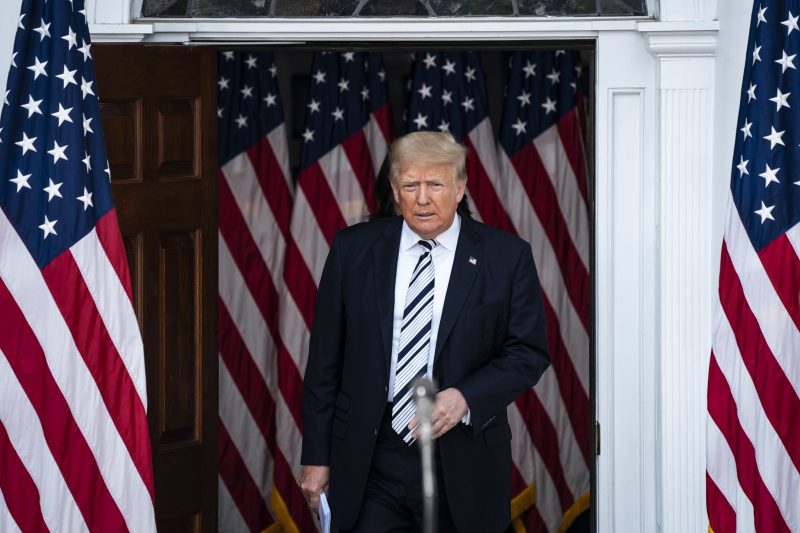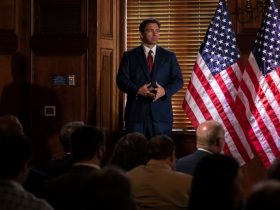It was mid- to late July 2021 and former president Donald Trump had decamped from his newly adopted Mar-a-Lago home for his summertime residence at his golf club in Bedminster, N.J. He’d been out of office for about half a year and was playing host to researchers working on the “autobiography” of his former chief of staff, Mark Meadows. Trump’s aide Margo Martin was there, recording the conversation as she typically did, just in case Trump wanted to challenge something his interviewers claimed.
That, by itself, is telling. Trump has the habit of preserving documentary evidence just in case he needed to use it for leverage. And, in the conversation with the Meadows team, he reportedly demonstrated how that worked.
At some point before the discussion, the New Yorker had run a story examining how Gen. Mark A. Milley, chairman of the Joint Chiefs of Staff, had sought to ensure Trump wouldn’t launch a war during his contentious last days in office. Trump, incensed, reportedly suggested to the researchers that he had a document that undercut the Milley narrative.
“Trump [brought] up the document, which he says came from Milley,” CNN’s Katelyn Polantz, Paula Reid and Kaitlan Collins reported Wednesday. “Trump told those in the room that if he could show it to people, it would undermine what Milley was saying, the sources said. One source says Trump refers to the document as if it is in front of him.”
This conversation was reportedly captured in the recording made by Martin, now in the hands of special counsel Jack Smith, who is investigating various matters involving Trump.
“Several sources say the recording captures the sound of paper rustling, as if Trump was waving the document around,” CNN’s report continues, “though is not clear if it was the actual Iran document.”
A central aspect of the recording is contained in that “if he could show it,” explained more directly by the Guardian’s Hugo Lowell.
“Trump talks about how he cannot discuss the document because he no longer possesses the sweeping presidential power to declassify now out of office,” Lowell reports, “but suggests that he should have done so when he was still in the White House.”
Such a recording may be legally inculpatory, certainly. But it also significantly damages Trump’s political case.
To the first point, it’s useful to remember the timeline. By May 2021, the National Archives and Records Administration (NARA) had contacted Trump’s attorneys to request the return of presidential records in accordance with the Presidential Records Act. In a May 6, 2021, email, NARA’s general counsel, Gary M. Stern, gently pressed Trump’s team to return any material taken by Trump.
“[I]t is absolutely necessary that we obtain and account for all original Presidential records,” Stern wrote.
That kicked off months of back-and-forth between Trump’s team and NARA before more than a dozen boxes of material were returned to D.C. in January 2022 — boxes that The Washington Post has reported were compiled with Trump’s oversight. That some of that material was classified triggered the initial FBI probe into Trump’s handling of documents.
A May 2021 email, of course, precedes a mid-July conversation by more than two months. It’s hard to believe that, by that point, Trump was unaware of the federal government’s position. It may be the case, though, that the overlapping question of possession of classified material had not yet been elevated.
That brings us to Trump’s political defense. To date, his defense of his retention of documents has taken two tracks. First, that everyone does it, a standard and inaccurate bit of Trumpian whataboutism. Second, that he had the right to declassify anything he wanted and, in fact, that everything in his possession was declassified.
To some extent, this is irrelevant, given that Trump was served with a subpoena for any documents with classification markings last year, with his attorneys then providing some but not all documents fitting that description. The search of Mar-a-Lago turned up more.
But a recording in which Trump claims that he wishes he could show a classified document to researchers to undercut Milley indicates 1) that he knew it was still classified, 2) that he had it in his possession and, potentially, 3) that he was in the habit of using the documents he took from the White House as rhetorical chits.
The former president’s attorney Jim Trusty appeared on CNN on Wednesday night, where he was asked about the reported recording. Among his claims were that Trump was president even when he arrived at Mar-a-Lago on Jan. 20, 2021, apparently important since it suggests he had the right, at least between his 11 a.m. landing and noon, when Joe Biden became president, to be in possession of — or to declassify — documents. Trusty also excoriated the Justice Department and FBI for “engaging in a leak campaign,” an attempt to shift the conversation to Trump’s preferred argument that the Deep State is simply out to get him.
CNN’s Abby Phillip, though, asked a pointed question. In April, Trusty was a signatory to a letter sent from Trump’s team to Congress in an obvious effort to leverage Trump-friendly legislators to perhaps derail the probe. In it, Phillip pointed out, Trump’s attorneys claimed that staffers simply swept a bunch of documents into boxes that were then transferred, sight unseen, to Mar-a-Lago.
“It seems this tape indicates at least Trump knew specifically that he had this specific document,” Phillip pointed out. In other words, Trump knew some of what was in those boxes.
Trusty deflected.
John Bolton was one of the dumbest people in government that I’ve had the “pleasure” to work with. A sullen, dull and quiet guy, he added nothing to National Security except, “Gee, let’s go to war.” Also, illegally released much Classified Information. A real dope!
— Donald J. Trump (@realDonaldTrump) November 15, 2020
There are a slew of other questions that emerge from this reported recording.
For example, it suggests that Trump might have had the Milley document at Bedminster. If he did, then either Trump brought the document back to Florida where it was turned over to (or seized by) the federal government or it remains in his possession — potentially at Bedminster where, last November, Trump’s attorneys say they oversaw a search for additional classified documents without success. His attorneys were similarly unsuccessful in finding classified documents when searching Mar-a-Lago after receiving the subpoena last year, you’ll recall.
More importantly, it suggests that Trump used classified documents precisely as security officials had feared. When CNN’s Collins asked Trump last month if he’d shown classified documents to anyone, he offered a verbal shrug.
“Not really,” he said. “I would have the right to. By the way, they were declassified after —”
“What do you mean ‘not really?’” Collins pressed.
“Not — not that I can think of,” Trump replied.
In the office at Mar-a-Lago where he received visitors, Trump had a special, leather-bound box that contained a number of documents with high-level classification markings. You’ve no doubt seen the picture of those documents arrayed on the Mar-a-Lago carpet after the FBI seized the box.
Americans (and the special counsel) are asked to believe that those documents were simply slipped into that box and carried to Trump’s office, that they remained there for well over a year untouched and unseen by anyone without the proper clearance. That his lawyers somehow overlooked those documents when responding to the subpoena. That Trump, so eager to have leverage in his various feuds and disputes, never dipped into that box to brandish something that might make a point to someone else about some other fight.
Occam’s razor would suggest we accept the obvious, simpler explanation.








